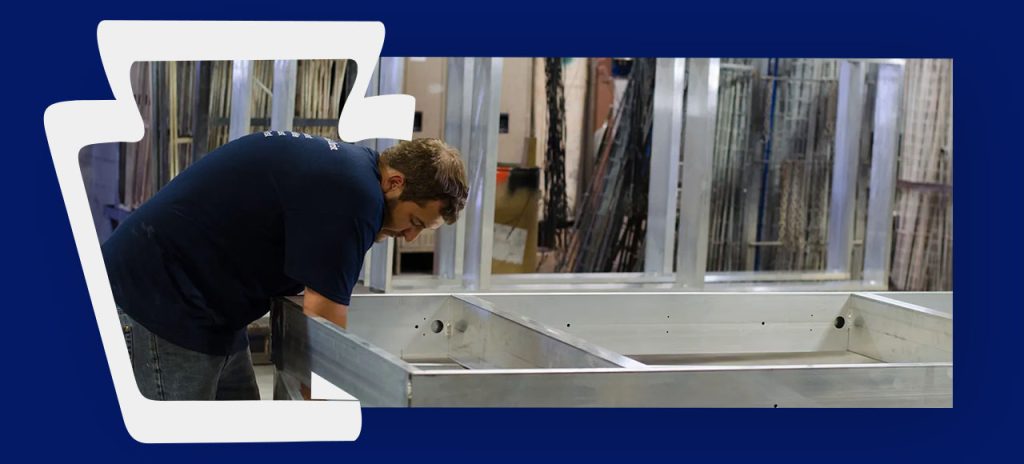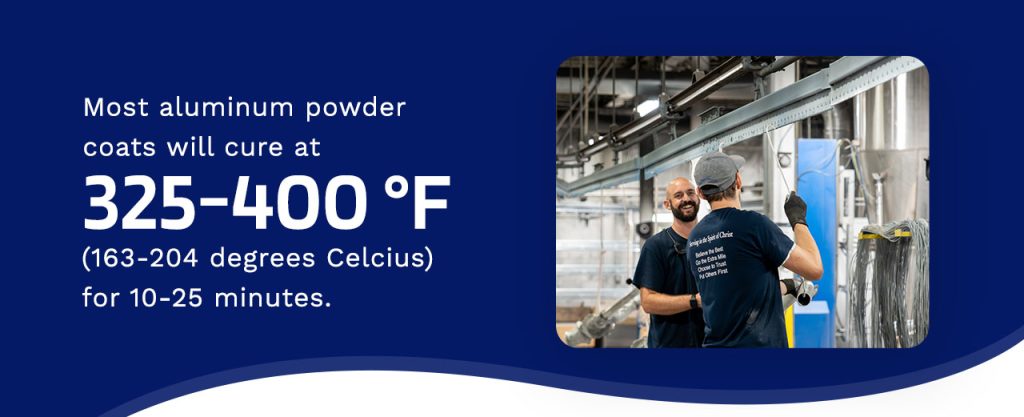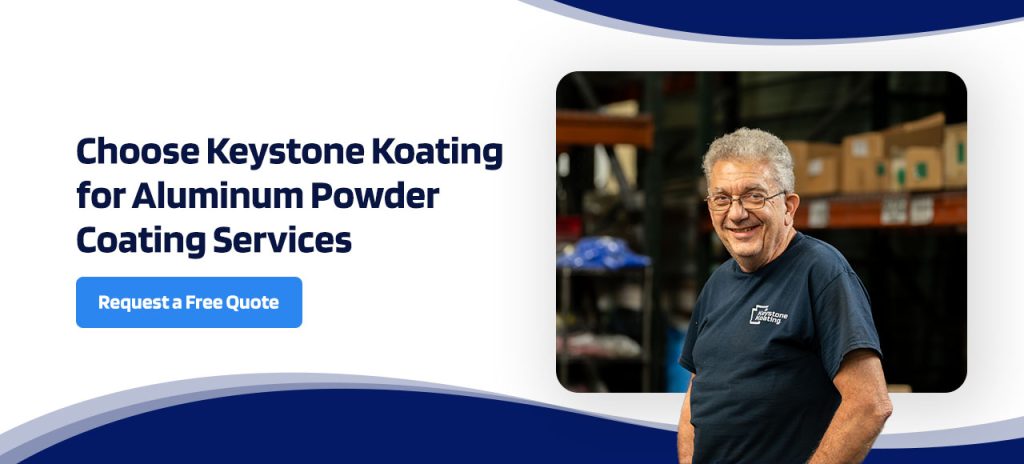
Powder coating aluminum is a process that produces versatile, sustainable finishes. Powder-coated aluminum is useful for industries as diverse as aerospace and architecture, along with many others. This step-by-step guide will explain the process of powder coating aluminum.
Overview of Powder Coating Aluminum
Manufacturers and product fabricators send their aluminum products for powder coating as a finish for several reasons. The main benefits of this finish include:
- Enhancing aluminum’s natural corrosion resistance and durability
- Improving a product’s aesthetics by applying an attractive finish
- Reducing waste through a finishing process that can recycle excess powder
Before beginning, manufacturers will determine their specifications for the end product. The actual process of powder coating aluminum involves up to 11 different steps:
Step 1: Blasting
Before preparing aluminum for powder coating, it is essential to ensure the material is free of inorganic contaminants like grease, rust or debris. If the material is being repurposed, any previous finish also needs to be removed. This is achieved through abrasive blasting to prepare the surface.
This step contributes to better powder coat adhesion and enhanced finish durability.
Step 2: Pre-Treating the Aluminum
Once the aluminum is clean, it is ready for pretreatment. Methods vary, but Keystone Koating’s thorough aluminum pretreatment process has eight stages:
- An alkaline cleaner removes any contaminants left after blasting.
- An alkaline rinse removes the leftover cleaning agent from step one.
- A second alkaline rinse ensures that all traces of contaminants and cleaning agents are gone.
- An ion phosphate solution pickles the surface and forms a coat to improve powder coat adhesion and prevent corrosion.
- A targeted rinse removes the ion phosphate from the surface.
- A second rinse ensures all traces of ion phosphate have been removed.
- A reverse osmosis wash eliminates any potential for remaining chemical or environmental contamination.
- The coating professionals cover the surface in a chrome-free, dry-in-place zirconium sealer for optimal powder coat adhesion.
Using a thorough pretreatment process during aluminum powder coating can sometimes eliminate the need for additional abrasive blasting.
Step 3: Masking
If the powder coating is for an aluminum component with holes, threads or machined areas that need to stay clean, masking blocks off those areas to protect them during powder coat application. Masking is also helpful for creating straight lines across a surface.
Special, high-temperature masking tape that can survive temperatures approaching 400 degrees Fahrenheit is necessary for this process.
Step 4: Priming the Surface
This is an optional step but an impactful one, especially for products intended for outdoor use. Applying a quality non-zinc primer coat to the aluminum before the powder coating can prevent corrosion, even in severe weather and environments with high moisture and high airborne salinity. The most effective primers on the market can extend the life span of a powder coat four times over.
If longevity is important to you, it is wise to ask your coating partner to use a primer before applying the powder coat.
Step 5: Applying the Powder Coat
With the aluminum surface clean, pretreated, masked and primed, the next step is to apply the powder coat. The powder itself could be epoxy, polyester or fluoropolymer, depending on the component’s application. While other methods exist, electrostatic spraying is the most versatile and precise way to apply powder coating to aluminum components.
This method uses electrostatic spray guns to apply the powder coat. The guns charge the powder particles with electrostatic energy on their way out of the spray nozzles. The coating then forms a strong electrostatic bond with the aluminum surface. This process continues until the component is fully coated with powder for the desired finish and thickness. The electrostatic bonds are so strong that the coat can protect the aluminum for years or even decades.
Step 6: Curing the Coat

Next, the freshly applied coat requires curing in an oven. Curing melts the resins in the powder to form a durable coat. Most aluminum powder coats will cure at 325-400 degrees Fahrenheit (163-204 degrees Celcius) for 10-25 minutes. Coating professionals calculate the exact time and temperature to cure a coat based on factors like:
- Coating thickness
- Substrate material
- Component size
- Powder formulation
Through careful optimization of curing time and temperature, coating professionals ensure an even, durable finish.
Step 7: Cooling
After leaving the curing oven, the component must cool down. This is when the powder solidifies to form a hardy protective layer over the aluminum surface. Proper cooling is crucial to prevent thermal stress, minimize the potential for defects and enable professionals to handle the component safely while inspecting and packaging it.
Leaving the component to cool naturally ensures gentle acclimation to the ambient temperature. However, in some cases, the material or conditions may demand more rapid cooling methods, including:
- Forced air cooling
- Cooling chambers
- Water quenching
Step 8: Quality Testing
After cooling, the powder coat is complete. A reputable coating professional will conduct rigorous inspection and quality testing before returning a coated component to a client. Top-tier quality control combines an experienced eye with specialized testing equipment to check the coat’s adhesion, thickness, cure and appearance.
Keystone Koating conducts these checks in a quality assurance laboratory dedicated to thorough testing and top-quality standards. Our testing procedures follow the quality and reliability standards of the American Society for Testing and Materials (ASTM) and the American Architectural Manufacturers Association (AAMA). We also hold ISO 9001-2015 certification.
Quality testing ensures the coat meets the coating company’s standards and the client’s specifications.
Step 9: Assembly
Once the component passes quality control, it is ready for packaging and shipping. If your component requires assembly, most coating professionals will return the coated parts to you to assemble yourself. However, if you choose Keystone Koating, you can ask for minor assembly on-site as a value-added service.
Step 10: Packaging
The powder-coated aluminum component is placed in protective packaging for convenient shipping. If your component is destined for the retail or wholesale market, provide Keystone Koating with the packaging materials and specifications and request custom packaging as a value-added service. This ensures the presentation standards you want your customer to experience.
Step 11: Shipping
Explore the shipping options your coating partner offers to ensure a delivery that meets your timeline. Keystone Koating provides multiple fast shipping options to suit your needs and preferences. Arrange a direct shipping schedule that gets all your completed orders to your location on time.
Why Trust Keystone Koating for Aluminum Powder Coating?
At Keystone Koating, we provide professional, attentive coating services informed by over 30 years of experience in the industry. We have spent decades innovating powder coating technology to meet your finishing needs.
Our ISO 9001-2015, AAMA, JLG and other certifications and verifications reflect our commitment to quality, compliance and consistency. This same commitment drives us to implement meticulous quality testing through our own quality assurance laboratory as well as independent verification processes. Because of our rigorous quality standards and consistent service delivery, we have been recognized as a Top Shop by Products Finishing magazine — a leading industry publication.

Choose Keystone Koating for Aluminum Powder Coating Services
Keystone Koating has over 30 years of industry experience and the capacity to powder coat the volume of aluminum components you need.
Along with precise electrostatic spraying, our process includes a meticulous eight-step pretreatment and exacting inspections in our quality testing lab. Each aspect of our powder coating process is designed to optimize quality, durability and aesthetics. We also offer custom packaging and fast, direct shipping to get your product where you need it, when you need it.
Request a free quote from Keystone Koating to start your coating project.

